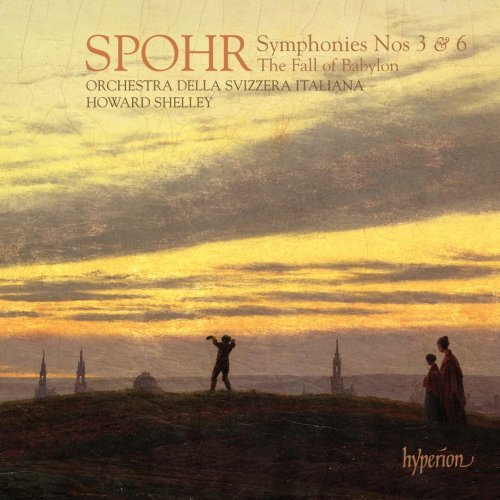Howard Shelley - Spohr: Symphonies Nos. 3 & 6, Overture 'Der Fall Babylons' (2010)

Artist: Howard Shelley
Title: Spohr: Symphonies Nos. 3 & 6, Overture 'Der Fall Babylons'
Year Of Release: 2010
Label: Hyperion
Genre: Classical
Quality: FLAC (image+.cue,log,booklet)
Total Time: 64:02
Total Size: 289 Mb
WebSite: Album Preview
Tracklist: Title: Spohr: Symphonies Nos. 3 & 6, Overture 'Der Fall Babylons'
Year Of Release: 2010
Label: Hyperion
Genre: Classical
Quality: FLAC (image+.cue,log,booklet)
Total Time: 64:02
Total Size: 289 Mb
WebSite: Album Preview
Louis Spohr (1784–1859)
[1] Overture ‘Der Fall Babylons’ WoO 63
[2]-[5] Symphony No 3 in C minor Op 78
[6]-[9] Symphony No 6 in G major ‘Historical Symphony’ Op 116
Performers:
Orchestra della Svizzera Italiana
Howard Shelley, conductor
In his long life, Louis Spohr found himself to be a contemporary of Ludwig van Beethoven, Hector Berlioz, Franz Liszt, and Richard Wagner, yet in spite of living in the turbulent first half-century of the Romantic era, he continued to emulate the music of Wolfgang Amadeus Mozart and stayed rather close to the practices and expressions of the late Classical era. To be sure, there are aspects of Spohr's music that suggest the increasing emotionalism and drama of Romanticism, as in the Symphony No. 3 in C minor, Op. 78 (1828), where the music often resembles the evocative scene painting of Felix Mendelssohn or Carl Maria von Weber, and in the Symphony No. 6 in G major, "Historical Symphony," Op. 116 (1839), where inflated Romanticism is overtly lampooned in the Finale. Yet at heart, Spohr observes the conventional forms and developmental ideas initiated by Franz Joseph Haydn and perfected by Mozart, so there is no escaping the feeling that his heart belonged in the 18th century, even as his ears were increasingly drawn toward the styles, sonorities, and effects of his own time. This recording by Howard Shelley and the Swiss-Italian Radio Orchestra is part of a series covering Spohr's symphonies, which also includes other orchestral pieces, such as this CD's Overture, "The Fall of Babylon" (1840), as intriguing filler. The performances are energetic and buoyant, and Hyperion's recording is clear and radiant. But these compositions are still fairly obscure and barely known even by Spohr fans, and they aren't as well-known or as characteristic as his chamber music, of which the Nonet, the Octet, and the four double quartets are his most popular. Beginners should sample Spohr's chamber music first, and perhaps approach these charming symphonic works later.


![Santi Vega - Un Instante Infinito (2025) [Hi-Res] Santi Vega - Un Instante Infinito (2025) [Hi-Res]](https://img.israbox.com/img/2025-12/19/xkxaonr6q5o8ydwyf3z1c8tp5.jpg)
![Tomasz Stańko - Piece for Diana and Other Ballads (Polish Radio Sessions vol. 1/6) (2025) [Hi-Res] Tomasz Stańko - Piece for Diana and Other Ballads (Polish Radio Sessions vol. 1/6) (2025) [Hi-Res]](https://www.dibpic.com/uploads/posts/2025-12/1765788761_cover.jpg)

![Travis Jenkins Piano Trio - Jazz in Meanjin 020 (Live at JMI) (2025) [Hi-Res] Travis Jenkins Piano Trio - Jazz in Meanjin 020 (Live at JMI) (2025) [Hi-Res]](https://www.dibpic.com/uploads/posts/2025-12/1765862611_a2068783921_10.jpg)

![Paul Mauriat - L'avventura (1972) [Hi-Res] Paul Mauriat - L'avventura (1972) [Hi-Res]](https://img.israbox.com/img/2025-12/19/q8l5an3pdrx7j3uta0q4cr2qi.jpg)
